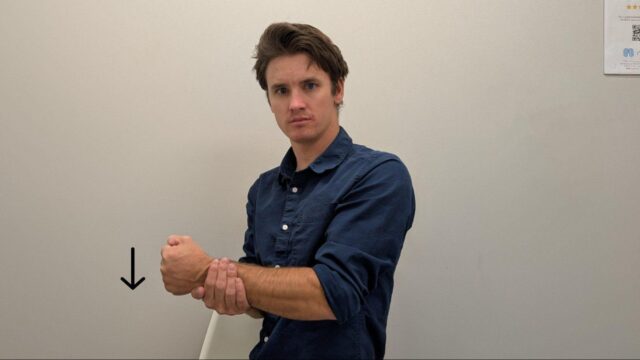By: John Crawley, PT, DPT, OCS
Introduction
Lateral elbow pain is a common complaint among rock climbers, often impacting performance and enjoyment of the sport. While several conditions can cause this discomfort, two primary culprits are wrist extensor tendinopathy and triceps referral pain. Distinguishing between these conditions is necessary for effective treatment and rehabilitation. In this article, we’ll delve into the signs, symptoms, and differential diagnosis of lateral elbow pain in rock climbers, along with specific exercises to address each condition.
Understanding Wrist Extensor Tendinopathy
Wrist extensor tendinopathy, commonly known as “tennis elbow,” involves inflammation or degeneration of the tendons in the forearm, particularly those attached to the lateral epicondyle of the elbow. Rock climbers frequently engage these muscles during repetitive gripping and pulling motions, making them susceptible to overuse injuries.
Signs and symptoms of wrist extensor tendinopathy include:
- Pain and tenderness on the outer side of the elbow, worsened by gripping or lifting objects, particularly with a flexed wrist.
- Weakness in the affected forearm muscles.
- Stiffness and limited range of motion in the wrist and elbow joints.
Triceps Referral Pain
Triceps referral pain occurs when dysfunction or injury in the triceps muscle refers pain to the lateral aspect of the elbow. This condition may mimic the symptoms of wrist extensor tendinopathy, leading to misdiagnosis if not carefully assessed.
Common signs and symptoms of triceps referral pain include:
- Deep, aching pain on the outer side of the elbow, often aggravated by pushing or extending movements such as with mantles, press outs, and gastons.
- Pain that radiates from the triceps muscle down to the elbow, sometimes accompanied by muscle tightness or knots.
Differential Diagnosis in Rock Climbers
Rock climbers frequently engage in movements that stress both the wrist extensors and triceps muscles. Therefore, distinguishing between these two conditions can be challenging but essential for effective treatment. A thorough examination, including assessing pain triggers, range of motion, and muscle strength, is crucial in making an accurate diagnosis.
Special Tests
Extensor Tendinopathy:

Resisted wrist extension
Move your hand backward so your knuckles move toward your forearm. Apply resistance against that direction of movement. If the pain in the lateral elbow intensifies with the resistance the test is considered positive.

Passive wrist extension
Place the unaffected hand on the back of the target hand and move it into flexion which is the direction of the palm with the elbow fully straightened. If this provokes the elbow pain it is considered a positive test.

Maudsley’s Test
With the elbow extended and the wrist flexed push on the middle finger with the unaffected hand while the affected side resists the finger flexion. If it reproduces your familiar pain the test is considered positive.
Triceps referral pain

Resisted elbow extension
The target side’s elbow bent to 90 degrees. Then grab the target arm with the other hand just above the wrist. Push down with the tested side resisting with the opposite arm. If pain is produced the test is considered positive.

Palpation of the triceps muscle bellies
Put pressure on the muscles of the back of the upper arm. If it alters the pain in the elbow, consider working on your triceps.
Treatment Strategies
Wrist Extensor Tendinopathy
To alleviate symptoms of wrist extensor tendinopathy, rock climbers can benefit from eccentric strengthening exercises for the forearm muscles.
Tyler Twist
Hold a lightweight dumbbell or a resistance band in the hand of the affected arm, palm facing down. With the elbow bent at 90 degrees, slowly lower the weight by extending the wrist.
Return to the starting position by flexing the wrist.
Perform 2-3 sets of 10-15 repetitions, gradually increasing the resistance as tolerated.
Triceps Referral Pain
For triceps referral pain, stretching and myofascial release techniques can help alleviate tension and discomfort.
Overhead Triceps Extension
Standing with the upper arm positioned vertically and elbow bent. Push the weight up, straightening the elbow. Once the elbow is straightened out, bring the weight back down by bending the elbow under control.
Perform 3 sets of 10-15 repetitions with a weight that is pain free.
Conclusion
While these exercises can provide relief, a comprehensive rehabilitation program tailored to individual needs is essential for long-term recovery from lateral elbow pain. If you’re experiencing persistent discomfort or difficulty with climbing due to elbow pain, consider consulting a physical therapist specialized in sports rehabilitation. They can assess your condition, provide personalized treatment strategies, and guide you through a safe return to climbing without pain or limitations. If you’re in the Boulder, Lafayette, and Longmont area, the experts at Mend can help you to effectively solve your lateral elbow pain.
